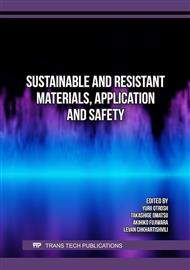[1]
D. G. Shvachko, V. Yu. Shcherbina, S. A. Borshchik, Thermal protection insulation in the lining of the rotary kilns. Modern engineering and innovative technologies. 16 (2021) 18–23.
Google Scholar
[2]
J. Szczerba, E. Śnieżek, V.Antonovič, Evolution of Refractory Materials for Rotary Cement Kiln Sintering Zone. Refractories and Industrial Ceramics. 58(4) (2017) 426–433.
DOI: 10.1007/s11148-017-0123-y
Google Scholar
[3]
I.D. Kashcheev, The Use of Refractories in the Lining of Rotary Cement Kilns, Refractories and Industrial Ceramics. 56(5) (2016) 483–485.
DOI: 10.1007/s11148-016-9873-1
Google Scholar
[4]
Á. Obregón, J. L. Rodríguez-Galicia, J. López-Cuevas, P. Pena, C. Baudín, MgO-CaZrO3-based refractories for cement kilns, Journal of the European Ceramic Society. 31(1-2) (2011) 61–74.
DOI: 10.1016/j.jeurceramsoc.2010.08.020
Google Scholar
[5]
G. Liu, N. Li, W. Yan, C. Gao, W. Zhou, Y. Li, Composition and microstructure of a periclase-composite spinel brick used in the burning zone of a cement rotary kiln Ceramics International. 40(6) (2014) 8149–8155.
DOI: 10.1016/j.ceramint.2014.01.010
Google Scholar
[6]
Q. Fan, D. Xueke, Y. Wengang, L. Guoqi, L. Hongxia, Research Progress of Magnesia Chrome Refractories and Their Applicationin Greenization for High Temperature Furnace. Materials Reports. 33(23) (2019) 3882–3891.
Google Scholar
[7]
A. Malfliet, S. Lotfian, L. Scheunis, V. Petkov, L. Pandelaers, P.T. Jones, B. Blanpain, Degradation mechanisms and use of refractory linings in copper production processes: A critical review. Journal of the European Ceramic Society. 34(3) (2014) 849–876.
DOI: 10.1016/j.jeurceramsoc.2013.10.005
Google Scholar
[8]
M. Ludwig, E. Sniezek, I. Jastrzebska, R. Prorok, Y. Li, N. Liao, M. Nath, J. Vlcek, J. Szczerba, Corrosion Resistance of MgO and Cr2O3-Based Refractory Raw Materials to PbO-Rich Cu Slag Determined by Hot-Stage Microscopy and Pellet Corrosion Test. Materials. 15 (2022) 725.
DOI: 10.3390/ma15030725
Google Scholar
[9]
S. Belgacem, H. Galai, H. Tiss, Qualitative and quantitative investigation of post-mortem cement refractory: The case of magnesia-spinel bricks. Ceramics International. 42(16) (2016) 19147–19155.
DOI: 10.1016/j.ceramint.2016.09.077
Google Scholar
[10]
S. Liang, X. Yougang, L. Yun, Y. Shenghai, D. Wei, Interaction between magnesia-spinel refractory grains and cement clinker at high temperature. Journal of the Australian Ceramic Society. 53(2) (2017) 319–327.
DOI: 10.1007/s41779-017-0041-y
Google Scholar
[11]
O.M. Borysenko, S.M. Logvinkov, G.M. Shabanova, А.М. Іshchenko, V.О. Arefiev, Special features of the structure of modifier of periclase-spinel materials with an increased thermal shock re-sistance. Scientific research on refractories and technical ceramics. 122-123 (2023) 60–72.
DOI: 10.35857/2663-3566.122-123.07
Google Scholar
[12]
S. M. Logvinkov, O. M. Borysenko, A. A. Ivashura, H. M. Shabanova, V. M. Shumejko, A. M. Korohodska, Principles of ensuring thermal stability in innovative technology of periclase-spinel refractories. Voprosy Khimii i Khimicheskoi Tekhnologii. 5 (2024) 12–20.
DOI: 10.32434/0321-4095-2024-156-5-12-20
Google Scholar
[13]
O. Borisenko, S. Logvinkov, G. Shabanova, O. Mirgorod, Thermodynamics of Solid-Phase Exchange Reactions Limiting the Subsolidus Structure of the System MgO-Al2O3-FeO-TiO2. Materials Science Forum Submitted. 1038 (2021) 177–184.
DOI: 10.4028/www.scientific.net/msf.1038.177
Google Scholar
[14]
O. Borysenko, S. Logvinkov, G. Shabanova, Y. Pitak, A. Ivashura, I. Ostapenko, Subsolidus structure of the MgO – Al2O3 – FeO – TiO2 system. Chemistry & Chemical Technology. 16(3) (2022) 367–376.
DOI: 10.1063/5.0120139
Google Scholar


